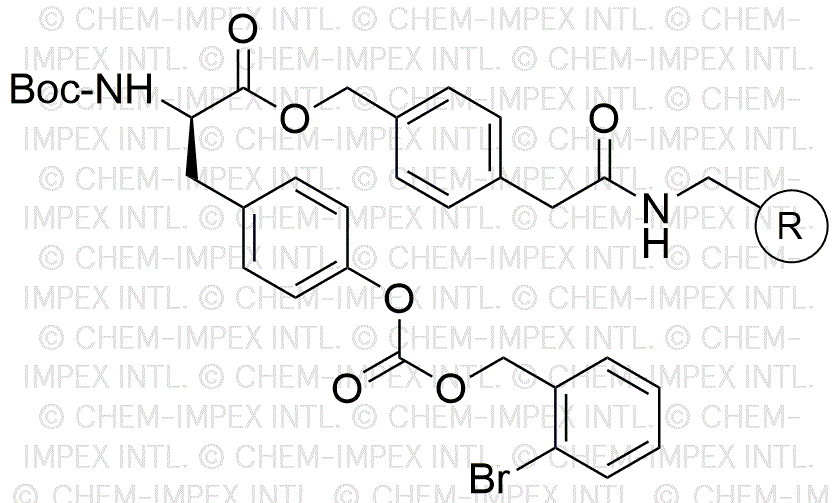Boc-O-2-bromo-Z-D-tyrosine 4-oxymethylphenylacetamidomethyl is widely utilized in research focused on:
- Peptide Synthesis: This compound serves as a valuable building block in the synthesis of peptides, particularly in creating modified amino acids that enhance the stability and bioactivity of therapeutic peptides.
- Drug Development: It plays a crucial role in medicinal chemistry for developing new drugs, especially in targeting specific receptors due to its unique structural properties that can improve binding affinity.
- Bioconjugation: The compound is used in bioconjugation techniques, allowing researchers to attach biomolecules to drugs or imaging agents, enhancing their efficacy and specificity in targeted therapies.
- Research in Neuroscience: This chemical is valuable in neuroscience research for studying the effects of modified tyrosine derivatives on neurotransmitter systems, potentially leading to new insights in neuropharmacology.
- Diagnostic Applications: It can be utilized in the development of diagnostic tools, where its unique properties allow for the creation of more sensitive assays for detecting specific biomolecules in clinical samples.
General Information
Properties
Safety and Regulations
Applications
Boc-O-2-bromo-Z-D-tyrosine 4-oxymethylphenylacetamidomethyl is widely utilized in research focused on:
- Peptide Synthesis: This compound serves as a valuable building block in the synthesis of peptides, particularly in creating modified amino acids that enhance the stability and bioactivity of therapeutic peptides.
- Drug Development: It plays a crucial role in medicinal chemistry for developing new drugs, especially in targeting specific receptors due to its unique structural properties that can improve binding affinity.
- Bioconjugation: The compound is used in bioconjugation techniques, allowing researchers to attach biomolecules to drugs or imaging agents, enhancing their efficacy and specificity in targeted therapies.
- Research in Neuroscience: This chemical is valuable in neuroscience research for studying the effects of modified tyrosine derivatives on neurotransmitter systems, potentially leading to new insights in neuropharmacology.
- Diagnostic Applications: It can be utilized in the development of diagnostic tools, where its unique properties allow for the creation of more sensitive assays for detecting specific biomolecules in clinical samples.
Documents
Safety Data Sheets (SDS)
The SDS provides comprehensive safety information on handling, storage, and disposal of the product.
Product Specification (PS)
The PS provides a comprehensive breakdown of the product’s properties, including chemical composition, physical state, purity, and storage requirements. It also details acceptable quality ranges and the product's intended applications.
Certificates of Analysis (COA)
Search for Certificates of Analysis (COA) by entering the products Lot Number. Lot and Batch Numbers can be found on a product’s label following the words ‘Lot’ or ‘Batch’.
Número de catálogo
Número de lote/lote
Certificates Of Origin (COO)
This COO confirms the country where the product was manufactured, and also details the materials and components used in it and whether it is derived from natural, synthetic, or other specific sources. This certificate may be required for customs, trade, and regulatory compliance.
Número de catálogo
Número de lote/lote
Safety Data Sheets (SDS)
The SDS provides comprehensive safety information on handling, storage, and disposal of the product.
DownloadProduct Specification (PS)
The PS provides a comprehensive breakdown of the product’s properties, including chemical composition, physical state, purity, and storage requirements. It also details acceptable quality ranges and the product's intended applications.
DownloadCertificates of Analysis (COA)
Search for Certificates of Analysis (COA) by entering the products Lot Number. Lot and Batch Numbers can be found on a product’s label following the words ‘Lot’ or ‘Batch’.
Número de catálogo
Número de lote/lote
Certificates Of Origin (COO)
This COO confirms the country where the product was manufactured, and also details the materials and components used in it and whether it is derived from natural, synthetic, or other specific sources. This certificate may be required for customs, trade, and regulatory compliance.


